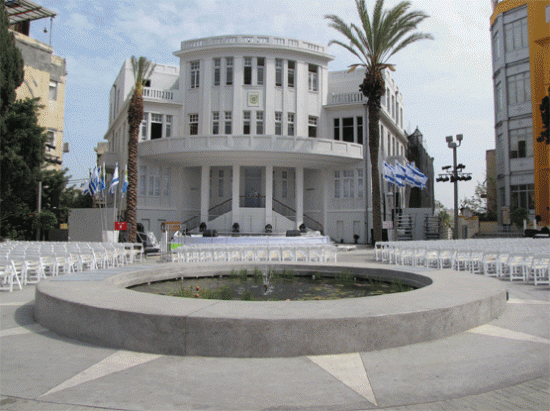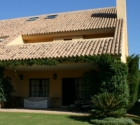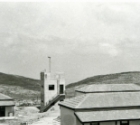
The former city hall in Bialik Street Circle, without the Nachum Gutman fountain
Chaim Nachman Bialik was born in the Ukraine in 1873 and later became known as Israel’s “national poet”. Bialik was most famous for his two poems about the Kishinev pogroms in Russia. The second poem, "Be-Ir ha-Haregah" ("In the City of Slaughter," 1904), was a searing denunciation of the Jews’ meek submission to the massacre, in which he is bitter at the absence of justice, and struck by the world’s indifference - and even the indifference of nature - "The sun shone, the acacia blossomed, and the slaughterer slaughtered." This poem resonated with the Zionist feelings of Jews, especially those living in Eastern Europe and, of course, those who had immigrated to Palestine.
Our guide, Yona, recently described Bialik’s sojourn in Palestine to a group of us at the corner of the street named for him in Tel Aviv. In 1924, fifteen years after the founding of the first modern Jewish city, Tel Aviv, Bialik and his wife left Berlin after a three year stay and arrived in Tel Aviv, where they were given a splendid reception by Mayor Meir Dizengoff - a friend of the poet - who informed them that a street was to be named in the poet’s honor.
At that time the growing city was a collection of village-like neighborhoods consisting mostly of one storey houses. Though the population barely reached 17,000, Tel Aviv was already full of contagious excitement. The fourth aliyah (wave of immigration) was just beginning. Most of the new immigrants were middle-class and brought with them modest sums of capital with which they established small businesses and workshops. It was during this period that Tel Aviv began its transformation into a real metropolis.
As we strained to hear Yona’s commentary above the din of the traffic and the noise of loud conversation at the adjacent café, which was one of Tel Aviv’s earliest gathering spots, it was hard to imagine that when Dizengoff and Bialik had stood here so long ago there were no buildings blocking the view of the beach. In fact, sand dunes surrounded them and donkeys and camels were common beasts of burden. Yona soon led us down the short street towards Bialik House, explaining about the architecture of the buildings and the stories of many of their inhabitants along the way.
Beginning in 1924 and continuing until the end of the decade, the style of building in Tel Aviv was “eclectic”, a classical architecture with Oriental [Arab] features such as arched windows plus Jewish ceramic motifs. Because there was no “Jewish architecture”, the builders added biblical figures and Jewish symbols to the columns and arches to create a Jewish feeling. A number of the oldest original houses on Bialik Street were in the eclectic style, many with ornamental ponds in their gardens. The inhabitants, many of whom had homes without baths, would put live carp in these ponds shortly before the Sabbath. Later these carp were to be clubbed on the head and made into gefilte fish.
In the decade of the 1930s there was a huge German influence on the burgeoning city’s architecture, from Palestinian (Jews born in Palestine) architects who studied in Germany and from new immigrants who had left Germany and Europe to practice architecture in Tel Aviv. More than 4,500 buildings were designed by more than 60 architects in the international style, which in Tel Aviv was called “Bauhaus” after the famous German design school of the same name in Dessau, Germany. We saw many of these on Bialik Street. This simple, unornamented style was designed within a social context, primarily for the working class. Because thousands of these buildings are still standing (the majority in great need of extensive renovation), Tel Aviv is called the White City and has been accorded the status of UNESCO World Heritage Site. (Most of the international style buildings in Europe were destroyed during WWII.)
Due to Tel Aviv’s Mediterranean climate, the architects made adjustments to the international style buildings, adding deep, rounded balconies, flat roofs and smaller, horizontal windows to cut out the glare of the Mediterranean sun. The exteriors were whitewashed with either smooth or rough plaster over bricks. The idea was to build an apartment that would be cool in summer and comfortably warm in the winter. Therefore, the living rooms generally faced west and the bedrooms faced east. The apartment units themselves were quite small and the inhabitants spent much of their time on the balconies, which sometimes had modifications to increase the circulation of ocean breezes.
After Israel’s independence in 1948, the new state was inundated with immigrants from European and Arab countries. The Bauhaus style was overtaken by a simpler, cheaper type of construction which could be quickly mass-produced, called “blokim”. Similarly to the Bauhaus buildings, blokim were built on pillars one level above ground for circulation and additional public space. The balconies were enclosed to enlarge the living room/dining area and the apartments were usually given glass sliding walls on the street side, with plastic shutters to control the shade. There was only one of this type of building on upscale Bialik Street, but it had been “dressed up” with glazed tile to attempt to fit in with its more fancy neighbors.
It took us a while to traverse the short street to its end at Bialik Square thanks to all Yona’s explanations and stories. Around the square are the street’s most significant buildings: the Rueven Rubin Museum (once the home of one of Israel’s most beloved painters), Museum of the History of Tel Aviv-Jaffa (once the home of Mayor Dizengoff, later the city hall, and now being renovated), the Felicia Blumenthal Music Center auditorium (located in a beautiful former factory), the Bauhaus Museum (a small furniture exhibit located in a beautifully restored apartment house) and the ultimate goal of our tour, Beit Bialik.
Chaim Nachman Bialik was already a famous poet, acclaimed as the “national poet”, before he moved to the Yishuv (pre-state Palestine). In 1923, while still in Europe and on the jubilee of his birth, Bialik created a sumptuous four-volume set of his poetry which proved to be extremely successful. This provided him with the funds to build a fabulous house for himself and his wife on the street named after him.
Bialik’s house, designed by Y. Minor, is an outstanding example of the synthesis of European architecture with an Arab decorative motif. “Arches and columns beautify every corner of the house; in the oriental custom the roof was built flat to allow for a pleasant place to while away hot summer evenings, with a view of the city under construction; the windows of the building are low, as a protection against the harsh sun. The most obvious Oriental element is the tower topped by a dome. The hearth and the pillars are covered with decorated tiles, with Jewish themes, products of the Bezalel workshop in Jerusalem.” The dedication of the building took place during the festival of Succot, 1925. [www.mfa.gov.il]
Ironically, Bialik didn’t write poetry while living in his new home, but he did translation and other work there and had a sort of salon for all the well-known literary, scientific, Zionist and other luminaries who wouldn’t think of visiting Tel Aviv without stopping in at Beit Bialik. Tel Aviv was the logical place for the famous poet to reside, because to Bialik and others, Tel Aviv represented the home for the new Jew, the replacement for the “old” Jew who had been a victim and scapegoat for so long. But in 1933 the social pressures of being so famous proved to be too much for the elderly couple and the Bialiks moved to a smaller place in the Tel Aviv suburb of Ramat Gan. Sadly, the next year Bialik traveled to Vienna for an operation, where he died.
Tel Aviv is indeed a city for the new Jew, and is a wonderful counterweight to Jerusalem, Israel’s most famous city. Celebrating its centennial, Tel Aviv is showcasing innumerable events to keep its residents and visitors busy during 2009. We enjoyed our walk down this short street so full of the city’s history. Before leaving Bialik Street, we enjoyed lunch at the same location where Tel Aviv residents have dined for more than 85 years. But we had only a glimpse of the sea, due to the rampant construction over the last century, which perhaps Chaim Nachman Bialik and Mayor Dizengoff foresaw on that day of welcome in 1924.
 DEAR EDITOR 152
DEAR EDITOR 152 TIDBITS, COMMENTS AND ODDITIES-152
TIDBITS, COMMENTS AND ODDITIES-152 TAKE IT LIKE A SOLDIER - A MEMOIR - A Review
TAKE IT LIKE A SOLDIER - A MEMOIR - A Review-1450935317.jpg) Spending a Week in Tel Aviv
Spending a Week in Tel Aviv  Ma'ale Hachamisha
Ma'ale Hachamisha-1450857993.jpg) Jazz in a Pearl Garden
Jazz in a Pearl Garden  Steve Kramer
Steve Kramer